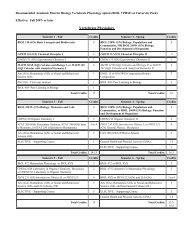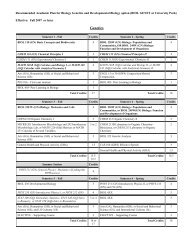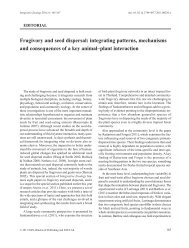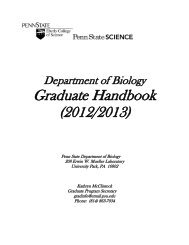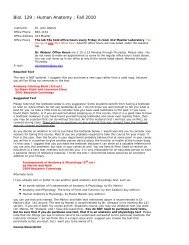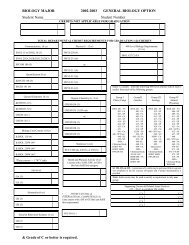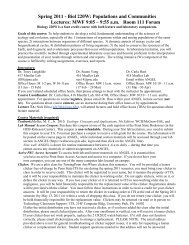Beth Shapiro Curriculum Vitae - Penn State University Department ...
Beth Shapiro Curriculum Vitae - Penn State University Department ...
Beth Shapiro Curriculum Vitae - Penn State University Department ...
You also want an ePaper? Increase the reach of your titles
YUMPU automatically turns print PDFs into web optimized ePapers that Google loves.
<strong>Beth</strong> <strong>Shapiro</strong> <strong>Curriculum</strong> <strong>Vitae</strong><br />
<strong>Department</strong> of Biology Born: 14 Jan 1976<br />
The <strong>Penn</strong>sylvania <strong>State</strong> <strong>University</strong> Citizenship: USA<br />
326 Mueller Laboratory<br />
<strong>University</strong> Park, PA 16802 USA<br />
FAX: +1 (814) 865-9131 Tel: +1 (814) 863-9178<br />
beth.shapiro@psu.edu http://www.bio.psu.edu/people/faculty/bshapiro/index.html<br />
Education:<br />
DPhil (Zoology) Oxford <strong>University</strong>, 2003.<br />
MS (Ecology) <strong>University</strong> of Georgia, 1999.<br />
BS (Ecology) <strong>University</strong> of Georgia, 1999 Suma Cum Laude, With Highest Honors.<br />
Current Position:<br />
Shaffer Career Development Assistant Professor, <strong>Department</strong> of Biology, The <strong>Penn</strong>sylvania<br />
<strong>State</strong> <strong>University</strong> (2007- present)<br />
Past Positions:<br />
Director, Henry Wellcome Ancient Biomolecules Centre, Oxford <strong>University</strong> (2004-2007)<br />
Royal Society <strong>University</strong> Research Fellow, Oxford <strong>University</strong> (2006-2007)<br />
Wellcome Trust Research Fellow, Oxford <strong>University</strong> (2004-2006)<br />
Selected Honors and Awards:<br />
PopTech Science and Engineering Fellow, 2010<br />
National Geographic Emerging Explorer, 2010<br />
MacArthur Fellow, 2009<br />
Session Speaker, Kavli Frontiers of Science, National Academy of Sciences 2009<br />
Visiting Fellow, Isaac Newton Institute for Mathematical Sciences, 2007<br />
Smithsonian Young Innovator, 2007<br />
<strong>University</strong> Research Fellow, The Royal Society, 2006<br />
Research Fellow, The Wellcome Trust, 2004<br />
Research Fellow, Balliol College, 2002, 2006<br />
Fellow, American Achievement Academy, 2001<br />
Rhodes Scholar, 1999<br />
Scientific Service:<br />
Associate Editor, Molecular Biology and Evolution (2007- current).<br />
Guest Editor: Proceedings of the National Academy of Sciences USA.<br />
Scientific Advisory Board: Museum of Beringia, Dawson City, YT (in development)<br />
Reviewer for >20 peer-review journals including Science, PLoS Biology, Current Biology, PNAS,<br />
Proc Roy Soc B, Biology Letters, Molecular Ecology.<br />
Professional Memberships:<br />
American Association for the Advancement of Science<br />
Society for Molecular Biology and Evolution<br />
International Biogeography Society<br />
American Archaeological Society<br />
<strong>Beth</strong> <strong>Shapiro</strong> -- CV ! 20 June 2010
Research Interests:<br />
Molecular evolution; Phylogenetics; Origins and evolution of RNA viruses; Ancient DNA;<br />
Extinction dynamics; Reconstructing demographic changes through time.<br />
Selected Invited/plenary talks:<br />
<strong>Shapiro</strong> B. Should we care about biodiversity? SciFoo. Googleplex. (July 2010).<br />
<strong>Shapiro</strong> B. Understanding extinction. National Geographic Society. Washington DC (June<br />
2010).<br />
<strong>Shapiro</strong> B. Measuring evolution through space and time. Boehringer Ingelheim Fonds Fellows<br />
Retreat. Cold Spring Harbor Lab. (October 2009).<br />
<strong>Shapiro</strong> B. Several millennia in the lives of polar bears. Max Planck Institute for Evolutionary<br />
Anthropology, Leipzig, Germany. (August 2009).<br />
<strong>Shapiro</strong> B. The rise and the fall of the Beringian megafauna. 15th Annual German-American<br />
Frontiers of Science Symposium. Alexander von Humbolt Foundation and the National<br />
Academy of Sciences. Irvine, California (April 2009).<br />
<strong>Shapiro</strong> B. Reconstructing demographic change through space and time. International<br />
Biogeography Society, Merida Mexico (January 2009).<br />
<strong>Shapiro</strong> B. Did we kill the Megafauna? Harvard Symposium on the Scientific Study of the<br />
Human Past. Harvard <strong>University</strong>, Cambridge, MA (December 2008).<br />
<strong>Shapiro</strong> B. How to clone a Dodo. DNA and Darwin Series, The Chautauqua Institute,<br />
Chautauqua, NY (August 2008).<br />
<strong>Shapiro</strong> B. Using gene sequences to trace evolution through time and space. Andrew W Mellon<br />
DNA and History seminar series, UCLA (January 2008).<br />
<strong>Shapiro</strong> B. Ancient DNA: advances in phylogenetic methods. Foundación Ramon Areces,<br />
Madrid, Spain (April 2007).<br />
Teaching and related experience:<br />
Biology 110 (PSU) Basic Concepts and Biodiversity. I co-teach this large (~700 student) course<br />
with three other faulty.<br />
Biology 439 (PSU) Practical Bioinformatics. I have developed a combined lecture/practical<br />
course to teach students current methods for the analysis of molecular sequence data.<br />
International Bioinformatics Workshop on Virus Evolution and Molecular Epidemiology. I am<br />
part of the core faculty for this annal, week-long workshop in which students are introduced<br />
to the latest methods to analyze molecular data from viruses.<br />
Ethics in Genetics (Oxford <strong>University</strong>). I developed and taught an intensive four-week course in<br />
which students were challenged to tackle ethical dilemmas arising from modern scientific<br />
advances.<br />
Biomolecular Evolution (Oxford <strong>University</strong>). I developed and taught a 3-week lecture/discussion<br />
course as part of the MSc in Archaeological Science, in which students are introduced to<br />
the basic concepts and application of ancient DNA.<br />
Public lecturer: Oxford <strong>University</strong> Museum of Natural History; Beringia Heritage Museum,<br />
Whitehorse, YT; Chautauqua Institution, NY<br />
Supervision:<br />
My laboratory currently consists of three PhD students, two Postdoctoral Research Associates,<br />
four Honors Dissertation candidates and two undergraduate researchers.<br />
I have previously (Oxford <strong>University</strong>) supervised three PhD students and six MSc students (four<br />
received distinctions for their research).<br />
<strong>Beth</strong> <strong>Shapiro</strong> -- CV ! 20 June 2010
Publication List<br />
Journal articles:<br />
(1) Ho SYW, Lanfear R, Phillips MJ, Barnes I, Thomas JA, Kolokotronis S-O, <strong>Shapiro</strong> B.<br />
Bayesian estimation of substition rates from ancient DNA sequences with low<br />
information content. Syst. Biol. (in press).<br />
(2) Richards M, <strong>Shapiro</strong> B, Ditchfield P, Cooper A. Bison bone collagen isotopic values track<br />
climate fluctuations and vegetation change in Late Pleistocene and Early Holocene<br />
Northern Eurasia and North America. Geol. J. (in press).<br />
(3) Firth C, Kitchen A, <strong>Shapiro</strong> B, Suchard MA, Holmes EC, Rambaut A. Using timestructured<br />
data to estimate evolutionary rates of double-stranded DNA viruses. Mol.<br />
Biol. Evol. (in press).<br />
(4) <strong>Shapiro</strong> B, Hofreiter M. The analysis of ancient human genomes: using next generation<br />
sequencing, 20-fold coverage of the genome of a 4,000-year-old human from<br />
Greenland has been obtained. Bioessays 32: 388-391 (2010).<br />
(5) Stack JC, Welch D, Ferrari MJ, <strong>Shapiro</strong> B, Grenfell BT. Protocols for sampling viral<br />
sequences to study epidemic dynamics. J. Roy. Soc. Interface 7: 1119-1127 (2010).<br />
(6) <strong>Shapiro</strong>, B. Book review: Reading the story in DNA by Lindell Bromham. Quart. Rev. Biol.<br />
85: 223 (2010).<br />
(7) Campos P, Willerslev E, Sher A, Axelsson E, Tikhonov A, Aaris-Sørensen K, Greenwood A,<br />
Kahlke R-D, Kosintsev P, Krakhmalnaya T, Kuznetsova T, Lemey P, MacPhee RD,<br />
Norris CA, Shepherd K, Suchard MA, Zazula GD, <strong>Shapiro</strong> B*, Gilbert MTP*. Ancient<br />
DNA analysis excludes humans as the driving force behind late Pleistocene musk ox<br />
(Ovibos moschatus) population dynamics. Proc. Natl. Acad. Sci. USA 107: 5675-5680<br />
(2010).<br />
(8) Kuhn TS, McFarlane K, Groves P, Moers AO, <strong>Shapiro</strong> B. Modern and ancient DNA reveal<br />
recent partial replacement of caribou in the southwest Yukon. Mol. Ecol. 19:<br />
1312-1318 (2010).<br />
(9) Haile J, Larson G, Owens K, Dobney K, <strong>Shapiro</strong> B. Ancient DNA typing of Archaeological<br />
Pig Remains Corroborates Historical Records. J. Arch. Sci. 37:174-177 (2010).<br />
(10)Edwards CJ, Magee DA, Park SD, McGettigan PA, Lohan AJ, Murphy A, Finlay EK,<br />
<strong>Shapiro</strong> B, Chamberlain AT, Richards MB, Bradley DG, Loftus BJ, Machugh DE. A<br />
complete mitochondrial genome sequence from a mesolithic wild aurochs (Bos<br />
primigenius). PLoS One 5:e9255 (2010).<br />
(11)Magiorkinis G, Magiorkinis E, Paraskevis D, Ho SYW, <strong>Shapiro</strong> B, Pybus O, Allain JP,<br />
Hatzakis A. The global spread of Hepatitis C Virus 1a and 1b: a phylodynamic and<br />
phylogeographic analysis PLoS Med. 6:e1000198 (2009).<br />
(12) Cordingly JE, Sundaresan SR, Larison BJ, <strong>Shapiro</strong> B, Rubenstein DI. Grevy’s zebra<br />
conservation: overcoming threats of isolation, genetic hybridization and<br />
demographic instability. Anim. Conserv. 12 520-521 (2009).<br />
(13) Bunce M, Worthy T, Phillips M, Holdaway R, Willerslev E, Haile J, <strong>Shapiro</strong> B, Scofield P,<br />
Drummond A, Kamp P, Cooper A. The evolutionary history of the extinct ratite moa<br />
and New Zealand Neogene paleogeography. Proc. Natl. Acad. Sci. USA 106:<br />
20646-20651 (2009).<br />
(14) Ramsden C, Charleston MA, Duffy S, <strong>Shapiro</strong> B, Holmes EC. Insights into the<br />
evolutionary history of an emerging livestock pathogen: Porcine Circovirus 2. J. Virol.<br />
83: 12813-12821 (2009).<br />
(15) Cordingly JE, Sundarisan SR, Fischhoff IR, <strong>Shapiro</strong> B, Ruskey J, Rubenstein DI. Is the<br />
endangered Grevy’s zebra threatened by hybridization? Anim. Conserv. 12: 505-513<br />
<strong>Beth</strong> <strong>Shapiro</strong> -- CV ! 20 June 2010
(2009).<br />
(16) Zazula GD, MacKay G, Andrews TD, <strong>Shapiro</strong> B, Letts B, Brock F. A Late Pleistocene<br />
steppe bison (Bison priscus) partial carcass from Tsiigehtchic, Northwest Territories,<br />
Canada. Quat. Sci. Rev. 28: 2734-2742 (2009).<br />
(17) Collins MJ, Penkman KEH, Rohalnd N, <strong>Shapiro</strong> B, Dobberstein RC, Rotz-Timme A,<br />
Hofretier M. Is amino acid racemization a useful tool for screening for ancient DNA in<br />
bone? Proc. Roy. Soc. B 276: 2971-2977 (2009).<br />
(18) Weinstock J. <strong>Shapiro</strong> B, Prieto A, Martin JC, Gonzáles BA, Gilbert MPT, Willerslev E. The<br />
Late Pleistocene distribution of vicuñas (Vicugna vicugna) and the “extinction” of the<br />
gracile llama (Lama gracilis): new molecular data. Quat. Sci. Rev. 28: 15-16 (2009).<br />
(19) Barnett R, <strong>Shapiro</strong> B, Ho SYW, Barnes I, Burger J, Yamaguchi N, Higham T, Wheeler, HT,<br />
Rosendhal W, Sher AV, Baryshnikov G, Cooper A. Phylogeography of lions (Panthera<br />
leo) reveals three distinct taxa and a Late Pleistocene reduction in genetic diversity.<br />
Mol. Ecol. 18: 1668-1677 (2009).<br />
(20) Rambaut A, Drummond AJ, Ho SYW <strong>Shapiro</strong> B. Accommodating the effect of ancient<br />
DNA damage on inferences of demographic histories. Mol. Biol. Evol. 26: 245-248<br />
(2009).<br />
(21) Rijsdijk KF, Hume JP, Bunnik F, Florens V, Baider C, <strong>Shapiro</strong> B, et al. Mid-Holocene<br />
vertebrate bone Concentration-Lagerstätte on oceanic island Mauritius provides a<br />
window into the ecosystem of the dodo (Raphus cucullatus). Quat. Sci. Rev. 28:<br />
14-24 (2009).<br />
(22) Wilson M, <strong>Shapiro</strong> B, Hills LV. Late Pleistocene northward-dispersing Bison antiquus<br />
from the Bighill Creek Formation, Gallelli Gravel Pit, Alberta, Canada, and the fate of<br />
Bison occidentalis. Can. J. Earth Sci. 45: 827-859 (2008).<br />
(23) Dalén L, Götherström A, <strong>Shapiro</strong> B. Recovery of DNA from footprints in the snow. Can.<br />
Field Nat. 12: 321-324 (2008).<br />
(24) <strong>Shapiro</strong> B. Engineered polymerases amplify the potential of ancient DNA. Trends<br />
Biotech .26: 285-287 (2008).<br />
(25) Ho SYW, Larson G, Edwards CJ, Heupink TH, Lain KE, Holland PWH, <strong>Shapiro</strong> B.<br />
Correlating Bayesian date estimates with climatic events and domestication using a<br />
bovine case study. Biol. Lett. 274: 1377-1385 (2008).<br />
(26) Ho SYW, Saarma U, Barnett R, Haile J, <strong>Shapiro</strong> B. The effect of inappropriate calibration<br />
in molecular ecological studies: three case studies PLoS ONE 3: e1615 (2008).<br />
(27) Barnett R, Yamaguchi N, <strong>Shapiro</strong> B, Sabin R. Ancient DNA analysis indicates the first<br />
English lions originated from North Africa, Contrib. Zool. 77: 7-16 (2008).<br />
(28) Kapoor A, <strong>Shapiro</strong> B, Shafer RW, Rhee S-Y, Delwart EL. Multiple independent origins of<br />
protease inhibitor resistance mutation in salvage therapy patients. Retrovirology 5: 7<br />
(2008).<br />
(29) Buckley M, Walker A, Ho SYW, Yang Y, Smith C, Ashton P, Oates JT, Cappellini E, Koonn<br />
H, Penkman K, Elsworth B, Ashford D, Solazzo C., Andrews P, Strahler J, <strong>Shapiro</strong> B,<br />
Ostrom P, Gandhi H, Miller W, Raney B, Zylber MI, Gilbert MTP, Prigodich RV, Ryan<br />
M, Rijsdijk KF, Janoo A, Collins M. Comment on “Protein sequences from Mastodon<br />
and Tyrannosaurus rex revealed by mass spectrometry” Science 319: 33 (2008).<br />
(30) Barnett R, Yamaguchi N, <strong>Shapiro</strong> B, Nijman V. Using ancient DNA techniques to identify<br />
the origin of an unprovenanced museum specimen, as illustrated by the identification<br />
of a 19th century lion from Amsterdam, Contrib. Zool. 76: 87-94 (2007).<br />
(31) Deforche K, Camacho, R., Laethem, KV, <strong>Shapiro</strong> B., Moreau Y, Rambaut A, Vandamme,<br />
AM, Lemey P. Estimating the relative contribution of dNTP pool imbalance and<br />
APOBEC3G/3F editing to HIV evolution in vivo. J. Comp. Biol. 14: 1105-1114 (2007).<br />
<strong>Beth</strong> <strong>Shapiro</strong> -- CV ! 20 June 2010
(32) Abecasis AB, Lemey P, Vidal N, de Oliveira T, Peeters M, Camacho R, <strong>Shapiro</strong> B,<br />
Rambaut A, Vandamme A-M. Recombination is confounding the early evolutionary<br />
history of HIV-1: subtype G is a recombinant. J. Virol. 81: 8543-51 (2007).<br />
(33) Ho SYW, <strong>Shapiro</strong> B, Phillips MJ, Cooper A, Drummond AJ. Evidence for time<br />
dependency of molecular rate estimates. Sys. Biol. 56: 515-522 (2007).<br />
(34) Barnes I, <strong>Shapiro</strong> B, Kuznetsova T, Sher A, Guthrie D, Lister A, Thomas MG. Genetic<br />
structure and extinction of the woolly mammoth. Curr. Biol. 17: 1072-1075 (2007).<br />
(35) Ho SYW, Heupink, TH, Rambaut, A, <strong>Shapiro</strong> B. Bayesian estimation of sequence<br />
damage in ancient DNA. Mol. Biol. Evol. 24:1416-1422 (2007).<br />
(36) Edwards CJ, Bollongino R, Scheu A, Chamberlain A, Tresset A, Vigne J-D, Baird JF,<br />
Larson G, Ho SYW, Heupink TH, <strong>Shapiro</strong> B, Freeman AR, et al. Mitochondrial DNA<br />
analysis shows a Near Eastern Neolothic origin for domestic cattle and no indication<br />
of domestication of European aurochs. Proc. Roy. Soc B. 274: 1377-1385 (2007).<br />
(37) Rector A, Lemey P, Tachezy R, Mostmans S, Ghim S, Van Doorslaer K, Roelke M, Bush<br />
M, Montali RJ, Joslin J, Burk R, Jenson A, Sundberg JP, <strong>Shapiro</strong> B, Van Ranst M.<br />
Ancient papillomavirus-host co-speciation in Felidae. Genome Biol. 8:R57 (2007).<br />
(38) Haile J, Holdaway R, Oliver K, Bunce M, Gilbert MTP, Nielsen R, Munch K, Ho, SYW,<br />
<strong>Shapiro</strong> B, Willerslev E. Ancient DNA chronology within sediment deposits: is DNA<br />
leaching a factor? Mol. Biol. Evol. 24: 982-989 (2007).<br />
(39) Lemey P. Kosakovsky-Pond SL, Drummond A, Pybus O, <strong>Shapiro</strong> B, Barroso H, Taveira<br />
N, Rambaut A. Synonymous substitution rates predict HIV disease progression as a<br />
result of underlying replication dynamics. PLoS Comp. Biol 3:e29 (2007).<br />
(40) <strong>Shapiro</strong> B, Rambaut A, Gilbert MTP. No proof that typhoid caused the Plague of Athens.<br />
Int. J Infect. Dis. 10:334-335 (2006).<br />
(41) <strong>Shapiro</strong> B, Rambaut A, Drummond AJ. Choosing appropriate substitution models for the<br />
phylogenetic analysis of protein-coding sequences Mol. Biol. Evol. 23: 7-9 (2006).<br />
(42) Poinar HN, Schwartz C, Qi J, <strong>Shapiro</strong> B, MacPhee RD, Buiges B, Tikhonov A, Huson D,<br />
Tonsho L, Auch A, Rampp M, Miller W, Schuster SC. Metagenomics to paleogenomics:<br />
large scale sequencing of mammoth DNA. Science 311: 392-394 (2006).<br />
(43) <strong>Shapiro</strong> B, Drummond AJ, Rambaut A, Pybus OJ, Holmes EC. A phylogenetic method<br />
for detecting positive epistasis in gene sequences and its application to RNA virus<br />
evolution. Mol. Biol. Evol 23:1724-1730 (2006).<br />
(44) Gilbert MTP, <strong>Shapiro</strong> B, Drummond A, Cooper A. Post-mortem DNA damage hotspots in<br />
Bison (Bison bison and B. bonasus) provide supporting evidence for mutational<br />
hotspots in human mitochondria. J. Arch. Sci. 32:1053-1060 (2005).<br />
(45) Drummond AJ, Pybus OG, <strong>Shapiro</strong> B, Rambaut A. Bayesian coalescent inference of past<br />
population dynamics from molecular sequences. Mol. Biol. Evol. 22:1185-1192<br />
(2005).<br />
(46) Bunce M, Szulkin M, Lerner HRL, Barnes I, <strong>Shapiro</strong> B, Cooper A, Holdaway RN. Ancient<br />
DNA provides new insights into the evolutionary history of New Zealand’s extinct<br />
giant eagle. PLoS Biol. 3(1) e20 (2005).<br />
(47) <strong>Shapiro</strong> B, Drummond AJ, Rambaut A, Wilson MC, Matheus P, Sher AV, Pybus OG, et al.<br />
Rise and fall of the Beringian steppe bison. Science 306: 1561-1565 (2004).<br />
(48) Gilbert MTP, Wilson AS, Bunce M, Hansen AJ, Willerslev E, <strong>Shapiro</strong> B, Higham TFG,<br />
Richards MP, O’Connell TC, Tobin DJ, Janaway RC, Cooper A. Ancient mitochondrial<br />
DNA from hair. Curr. Biol. 14: R463-464 (2004).<br />
(49) <strong>Shapiro</strong> B. Book review: Return of the Crazy Bird: the Sad, Strange Tale of the Dodo by<br />
Clara Pinto-Correia. Quart. Rev. Biol. 79: 197-198.<br />
<strong>Beth</strong> <strong>Shapiro</strong> -- CV ! 20 June 2010
(50) <strong>Shapiro</strong> B, Cooper A. Beringia as an Ice Age genetic museum. Quat. Res. 60: 94- 100<br />
(2003).<br />
(51) Willerslev E, Hansen AJ, Binladen J, Brand TB, Gilbert MTP, <strong>Shapiro</strong> B, Bunce M, Wiuf C,<br />
Gilichinsky DA, Cooper A. Diverse plant and animal genetic records from Holocene<br />
and Pleistocene sediments. Science 300: 791-795 (2003).<br />
(52) Nielsen-Marsh, CM, Ostrom PH, Gandhi H, <strong>Shapiro</strong> B, Cooper A, Collins MJ.<br />
Exceptional preservation in >55 ka BP bison bones demonstrated by protein and<br />
DNA sequences. Geology 30: 1099-1102 (2002).<br />
(53) Lalueza-Fox, C, <strong>Shapiro</strong> B, Bover P, Alcover JA, Bertranpetit J. Molecular phylogeny and<br />
evolution of the extinct bovid Myotragus. Mol. Phyl. Evol. 25 (3): 501-510 (2002).<br />
(54) <strong>Shapiro</strong> B, Sibthorpe D, Austin J, Wragg G, Lee PLM, Bininda-Emonds ORP, and Cooper<br />
A. Flight of the Dodo. Science 295: 1683 (2002).<br />
(55) Barnes I, Matheus P, <strong>Shapiro</strong> B, Jensen D, Cooper A. Dynamics of mammal population<br />
extinctions in eastern Beringia during the last glaciation. Science 295: 2267-2270<br />
(2002).<br />
(56) Beck CW, <strong>Shapiro</strong> B, Choksi S, Promislow DEL. A genetic algorithm approach to study<br />
the evolution of female preference based on male age. Evol. Ecol. Res 4: 275-292<br />
(2002).<br />
(57) <strong>Shapiro</strong> BA, Pickering J. Rainfall and parasitic wasp (Hymenoptera: Ichneumonoidea)<br />
activity in successional forest stages at Barro Colorado Nature Monument, Panana<br />
and La Selva Biological Station, Costa Rica. Agr. For. Ent. 2: 39-47 (2000).<br />
Book chapters:<br />
(1) <strong>Shapiro</strong> B, Gilbert MTP, Barnes I. Using DNA to investigate human evolution. In H<br />
Schutkowski, Between Biology and Culture. Cambridge <strong>University</strong> Press (2009).<br />
(2) Pybus OG, <strong>Shapiro</strong> B. Natural selection and adaptation of molecular sequences. In Lemey<br />
P, Salemi N, Vandamme A-M. The Phylogenetics Handbook. Cambridge Univ. Press<br />
(2009).<br />
(3) Barnett R, <strong>Shapiro</strong> B, Barnes I. Ancient DNA from vertebrate fossils. In Elias SA, Ed.<br />
Encyclopedia of Quaternary Science. Elsevier (2006).<br />
Books:<br />
(1) <strong>Shapiro</strong> B, Hofreiter M (Eds). Ancient DNA. Methods in Molecular Biology. Humana Press.<br />
(in preparation).<br />
Current External Research Support<br />
NSF ARC-0909456. Collaborative research: Understanding the role of environmental<br />
change on the long-term population dynamics of two extinct and one surviving<br />
arctic species. National Science Foundation. Submitted October 2008. $267,758<br />
over three years.<br />
DNA from ancient fecal pellets: Using rapidly evolving markers to reconstruct recent<br />
evolutionary dynamics of pathogens and their hosts. Submitted September 2008.<br />
Searle Scholars Program. $100,000 per year for three years.<br />
NASA Astrobiology Institute. PSARCIII: Signatures of life from Earth and beyond. Role: Co-I<br />
(one of 17). Christopher House, PI (2009-2014).<br />
NIH R01 GM083983-01. Synthesizing the evolution and ecological dynamics of acute RNA<br />
viruses: Comparative analyses and methods development. Rle: Co-I. B. Grenfell<br />
(Princeton) PI. (2006-2011).<br />
<strong>Beth</strong> <strong>Shapiro</strong> -- CV ! 20 June 2010
NIH R01 GM083601-01. Novel statistical models for synthesizing social networks and epidemic<br />
dynamics. Role: Co-I. David Hunter (PSU) PI (2007-2012).<br />
Melting treasure: recovering 700,000 years of evolutionary history from melting<br />
permafrost in the Yukon. $19,500 National Geographic (2010).<br />
<strong>Beth</strong> <strong>Shapiro</strong> -- CV ! 20 June 2010



